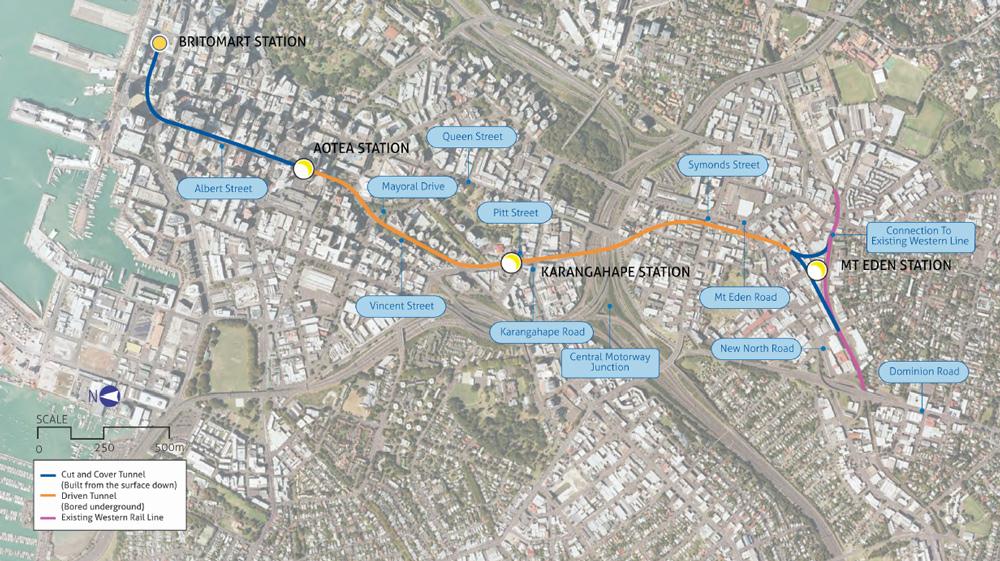
3 minute read
2. Project description
In order to launch the TBM and commence construction of the CRL tie-ins to the NAL, a range of ‘enabling’ works are proposed, which are the subject of this AQ DWP. These enabling works are described in detail in the CEMP.
In summary, the Mt Eden Enabling Works involve:
Continuation of the demolition and clearance of the Mt Eden CSA (these works are authorised under the Mt Eden Demolitions Outline Plan) Set up of a temporary site office, which is anticipated to be a 2-3 storey modular building (likely made up of containers) located in the western extent of the CSA. Piling and excavation associated with the preparation of the portal. This will involve the demolition of the redundant stormwater shaft located in the portal area; the installation of bored piles and associated works (ground anchors and shotcrete) to support the excavation face; and removal of spoil. Bulk excavation to form what will become the rail trenches/cut and cover tunnels, which will also provide a ramp for the TBM to be manoeuvred into position. The excavation will encounter basalt, which is to be blasted in order to expedite the works and minimise the amount of rock-breaking required. In places, softer ground conditions are anticipated to be encountered, which may require the use of sheet piles. Local mined tunnelling to facilitate the TBM launch. Construction of the additional Mt Eden Road bridge (north of the existing bridge), including temporary diversion of shallow utilities in this location. Construction of the Ruru Street bridge, including diversion of the Huia 2 watermain in this location. Temporary and permanent utility diversions (such as water, wastewater, stormwater, Vector overhead cables and ducting, gas and communications) along Fenton Street, Porters Avenue, Haultain Street and Wynyard Street to provide adequate clearance between the Huia 2 watermain and NAL, associated retaining walls, and the proposed Fenton Street pedestrian bridge.
Refer to the CEMP for a detailed description of the enabling works.
2.1 Construction methodology
The Project will be divided into stages as described in the CEMP.
2.2 Discharges to air
The main discharge to air from the construction activities outlined will be particulate matter (dust). Dust has the potential to cause nuisance or soil property if deposited in sufficient quantities in the environment. Fine dust particles and respirable crystalline silica (RCS) present in dust have the potential to affect respiratory heath while suspended in air. Dust from concrete crushing, breaking or handling is likely to have an increased RCS content.
The following activities have the potential to result in discharges of particulate matter to air:
Demolition activities (such as knocking down and breaking up of building material including plasterboard and blockwork, and cutting, breaking and crushing of concrete);
Excavation, drilling and mining; Outdoor spoil handling/removal; Wind erosion of spoil and other stockpiled material; Basalt blasting; Basalt crushing; Mixing of bentonite powder to form bentonite slurry; Mixing of cement to form grout; Backfilling of excavations; and Movement of vehicles over unsealed surfaces (this includes trucks, loaders and excavators required for the tunnel excavation and spoil removal, and the delivery of construction materials such as concrete and steel).
Other minor discharges to air could include:
Combustion emissions from vehicles on site, which can affect respiratory health in the environment with sufficient exposure; and Odour from excavation or disturbance of contaminated soil (if encountered), which has the potential to cause nuisance.
The potential for discharge of asbestos dust is not considered in this AQ DWP. Procedures for managing asbestos dust during demolition works are specified in the Air Quality DWP for Mt Eden Demolition. Procedures for managing asbestos encountered during excavations are specified in the Contamination Delivery Work Plan (C DWP).



